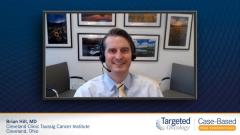
Results of the ZUMA-2 Trial in Relapsed/Refractory Mantle Cell Lymphoma
Brian Hill, MD, reviews practice-changing data from the ZUMA-2 trial in patients with relapsed/refractory mantle cell lymphoma.
Episodes in this series

Brian Hill, MD: Recently, there has been more widespread use of CAR [chimeric antigen receptor] T-cell therapy for B-cell malignancies. There have been significant successes and approvals for diffused B-cell lymphoma as well as ALL [acute lymphocytic leukemia]. In the ZUMA-2 trial, which was reported last year and updated in 2020, the KTE-X19, known as brexucabtagene autoleucel, was an anti-CD19 CAR T-cell therapy, which was given to over 70 patients at multiple centers with mantle cell lymphoma that had relapsed or been refractory to treatment with BTK inhibitors.
What was found in the ZUMA-2 study was that the overall response rate was very high, over 90%. The majority of the responses were complete remissions. The toxicities of brexucabtagene autoleucel were noteworthy for cytokine release syndrome and neurotoxicity. Overall, in the patients who were selected for this treatment, therapy was generally well tolerated, although it does require administration at an authorized treatment center or a center that has experience with CAR T-cell therapy.
With a long follow-up, as has been seen at this year’s ASCO [American Society of Clinical Oncology] Annual Meeting, the durable remissions remain at a very significant rate for mantle cell lymphoma. Historically, for patients who’ve had prior BTK inhibitors for treatment of mantle cell and then have stopped responding to the therapy, survival and PFS [progression-free survival] are generally measured in only a few months.
Certain disease characteristics of mantle cell lymphoma portend poor outcomes. Those include patients with blastoid morphology, as well as those with TP53 mutations or high Ki-67. And those 3 oftentimes go together.
In the ZUMA-2 trial, there were a significant proportion of patients who had some of these high-risk features. The clinical activity of brexucabtagene autoleucel in these patients was comparable with the activity and response rates that were seen in patients who had lower-risk disease biology.
Transcript edited for clarity.
Case: A 73-Year-Old Male With Mantle Cell Lymphoma
History
- A 73-year-old man was diagnosed with mantle cell lymphoma in 2016
- He was treated with rituximab, dexamethasone, cytarabine + carboplatin followed by autologous stem cell transplant; achieved PR; continued rituximab maintenance therapy
- Ann Arbor stage IV; MIPI score 6.7, high risk
- Late 2019 he experienced clinical relapse and was started on ibrutinib; achieved SD
Currently
- He complains of a 2-month history of loss of appetite and fatigue
- PMH: hyperlipidemia, medically well-controlled
- PE: bilateral clavicular and cervical lymphadenopathy; otherwise unremarkable
- Labs: WBC 11 X 109/L, hemoglobin 9.5 gm/dL, plt 96,000/u, LDH 405 U/I, ANC 3200/mm3
- Lymph node biopsy: IHC; cyclin D1+, CD5 +, CD10+, CD20+, FISH: t (11;14)
- C/A/P CT scan: widespread lymphadenopathy including bilateral clavicular (2.4 cm, 1.5 cm), and inguinal region (4.6 cm)
- PET/CT shows diffuse uptake of 18F-FDG in the clavicular, axillary and inguinal lymph nodes
- Beta-2-microglobulin 4.1 µg/L
- ECOG PS 0
- Treatment was started with fludarabine + cyclophosphamide, followed by a single infusion of CAR T-cell therapy











































